

EUROLAB laboratory provides testing and compliance services within the scope of ISO 12135 standard. This standard specifies methods for determining fracture toughness in terms of K, δ, J, and R.

Samples are notched, pre-cracked by fatigue, and tested under gradually increasing displacement. Fracture toughness is determined for individual specimens at the onset of or after ductile crack elongation or at the onset of ductile crack instability or unstable crack elongation.
Where cracks grow stably under ductile tearing conditions, a resistance curve is measured that describes fracture toughness as a function of crack elongation. In the testing of ferritic materials, in some cases, unstable crack elongation can occur with splitting or ductile crack initiation and growth, interrupted by split elongation. Fracture toughness in crack capture is not covered by this document.
The statistical variability of the results is highly dependent on the type of fracture; for example, fracture toughness associated with cleavage fracture in ferritic steels can vary widely.
For applications requiring high reliability, a statistical approach can be used to quantify the variability in fracture toughness in the ductile-brittle transition region, such as given in ASTM E1921. However, it is not the purpose of this document to specify the number of tests to be performed or how the results of the tests will be administered or interpreted.
The fracture toughness of metallic materials can be characterized either in terms of specific (single point) values or in terms of a continuous curve linking fracture resistance to crack elongation over a limited range of crack extension.
The procedures and parameters used to determine fracture toughness vary depending on the level of plasticity that occurs in the test specimen during testing. However, under any given set of conditions, any of the fatigue-pre-cracked test specimen configurations specified in this method can be used to measure any of the fracture toughness parameters considered. In all cases, tests are performed by applying gradually increasing displacements to the test specimen and measuring the forces and displacements performed during the test.
Forces and displacements are then used in conjunction with specific pretest and posttest sample measurements to determine fracture toughness, which characterizes the material's resistance to crack elongation. Details of the test specimens and general information about the determination of all fracture parameters are given in this method.
EUROLAB assists manufacturers with ISO 12135 test compliance. Our test experts, with their professional working mission and principles, provide you, our manufacturers and suppliers, the best service and controlled testing process in our laboratories. Thanks to these services, businesses receive more effective, high-performance and quality testing services and provide safe, fast and uninterrupted service to their customers.
To get an appointment, to get more detailed information or to request an evaluation, you can ask us to fill in our form and reach you.